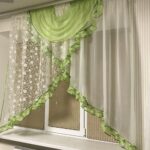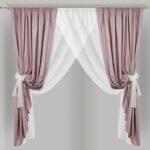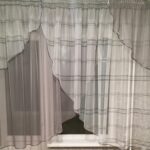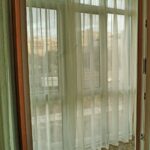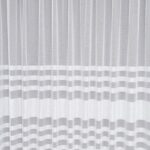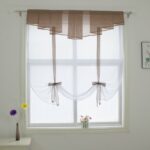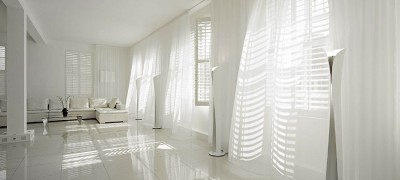Detailed overview of different tulle options
At the final stage of the arrangement of the premises, attention is paid to the design of the windows. For this, tulle is used - a material with a patterned or mesh fabric. This fabric is used to make weightless curtains for the living room and bedroom, as well as create light curtains and lambrequins. Such interior details can drastically change the look of rooms with a little effort.

What is tulle
The question of what tulle is, will be answered by its description. This is a woven material, the translucency of which is achieved by a special technology of weaving threads on curtain shuttleless or multi-shuttle looms. Smooth patterned material is made using lace-making on knitted machines. Another name for the fabric is bobbin, because of the weaving of threads twisted around each other by wound bobbins.
Additional Information! Many unknowingly confuse elite types of tulle with lace. It is used as inserts in underwear, silk shirts, capes and wedding dresses.

A patterned canvas is obtained in the following ways:
- Of three threads: the main one, passing along the canvas, forming a pattern and a background, which creates a pattern. The thread forming the pattern is laid with a jacquard device;
- On the shuttleless ones - from the main thread that forms the pattern. The main one forms wicker columns, and the pattern-forming one unites them;
- Weaving comes from the warp, weft and thread forming a pattern with tongue needles. The weft thread passes through three loops, forming cells. The thread that forms the pattern is applied to the main thread parallel to the weft thread. With the use of jacquard, the pattern will be plot with geometric and abstract lines.

Threads can be silk, cotton high twist, polyester, viscose, nylon and polyethylene terephthalate.
What is tulle for?
The versatility of the material made it in demand, especially when any variety looks presentable. Tulle can be found in every home. Tulle can be opaque depending on the weave and the type of thread. The curtains will close from the light from the windows, from prying eyes from the street. Curtain fabrics, thin with or without patterns, are used as interior textiles. Curtains will decorate the interior design, as well as help hide architectural inaccuracies.

History of origin
For the first time, tulle was made in the small weaving town of Tula in the south of France by order of King Henry VI for the bride Marguerite of Valois. The fabric turned out to be wonderful and they began to actively use it for sewing clothes. At that time, tulle was made by hand, with the help of primitive devices, was not affordable for ordinary people.
The first attempts to mechanize the fabric production process were taken in 1765 by James Hargreaves. He invented the spinning machine.
The shuttle machine appeared in the 19th century, designed by Master Hockett. This is how the production of canvases of different sizes began in a larger volume.With the modernization of technologies, it became possible to reduce the cost of production, which led to the use of tulle not only in clothes, but in the interior.

Varieties of tulle
Tulle on windows can differ in quality, structure, properties:
Chiffon fabric
Soft to the touch, with a matte texture, not too transparent. As a result of mixing different threads, jacquard satin, cotton and silk appeared. An image from a photograph, spraying, embroidery is imprinted on the surface, and a header is imprinted on the surface using steam.

Organza
Consists of silk threads and synthetics - polyester and viscose. The fabric is elastic and durable, with an unlimited service life. It does not need frequent washing, as it is resistant to dust and does not fade. It can be matte, shiny, of the same color and with a palette of paints, with a picture and a pattern.

Important! In case of tissue damage, the consequences cannot be eliminated, therefore, it is not recommended to hang organza curtains in a house where there are children and animals.
Fatin
Fully sheer micro-cage fabric made of nylon or polyester. Its surface is matte with a slight sheen. Plain fabric without additional details or with embroidery. Medium-hardness fabric looks good in voluminous folds. Not prone to puffing.

Crepe
With a fine-grained surface that emerges due to the large twist of the yarn. Does not wrinkle, wear resistant, difficult to tear or ruin. It is made of cotton, silk, with the addition of viscose, nylon and nylon, threads.

Gas
Formed from a plexus of threads, intertwined loosely with the formation of voids. It can be made of viscose and polyester, which reduces the price for the finished product. There is marabou, illusion and gas-rice.

Additional Information! On gas, 3D prints look spectacular and realistic.
Batiste
Natural linen and cotton fabric with a share of synthetic fibers, famous for its subtlety and tenderness. It drapes perfectly, dims the light from the windows, while the air passes freely through the fabric. Batiste is bleached, mercerized, printed and dyed.

Linen
Natural material, matt. There may be a completely synthetic version that mimics linen. Rigid threads retain their shape well, do not stretch.

Net
A simple weave of fibers forms an airy fabric with different sizes of drapery cells. It is made from natural raw materials with the addition of synthetic fiber. Has a different color and pattern, with lace, sequins and rhinestones.

Veil
Delicate, matte fabric. A translucent and pliable material made from natural threads with a high proportion of synthetics, which is distinguished by its smoothness. Used for rooms that require darkening, since the tulle does not shine through from the street.

Important! Washing heavy dirt on a delicate fabric will be a test, therefore it is not suitable for a window opening with a balcony and a kitchen.
How to choose the right tulle
The choice of tulle is based on several factors. In interior design, tulle should correspond to it, muffle pretentiousness, become an accent of a room or an addition to the overall style.
Depending on the size of the room: in a small room - limit yourself to modest options for lightweight fabrics; in a large one - with patterns, embroidery, which are folded into lush designs (organza, mesh, tulle).
Depending on the lighting: in dark rooms, transparent fabrics (gas, veil), and matte fabrics where you want to hide from the sun's rays (crepe, chiffon).
For living room and hall
In a spacious, bright room, the following are suitable:
- dense fabrics of dark shades;
- lambrequins: semicircular, folded, with ripples and waves;
- layered of several shades, one tone higher or lower, thin tulle;
- photo tulle with a large flower;
- gold embroidery, reaper or ruffles, lace inserts;
- tulle, saturated color over the curtains.

In a small living room - beige or cream curtains, possibly white and short, with small ornaments that visually do not steal the space of the room.
For bedroom
Delicate tulles are ideal for the bedroom. This could be:
- a spider-like spider-web curtain is an elegant addition to a rich interior;
- rain, so named for its external similarity, vertical stripes will visually make the window opening higher;
- double layer of the finest veil or micro-mesh of any color and shade;
- tulle to the windowsill, perhaps a net, as it forms a well-defined vertical fold, which looks good in a small bedroom;
- long, flowing fabric with geometric patterns in a spacious room.

For children's room
When choosing tulle for a nursery, it is worth basing on a contradiction, if the design of the room is colorful, then the curtain should be light, calm, and, conversely, a bright room is a bright accent on the window. The same principle with the size of the canvas: a wide tulle on a small window, possibly the entire width of the wall. This will expand the boundaries of the nursery.
Choose natural prints or cartoon characters that will interest your baby. Do not add unnecessary parts that will accumulate excess dust; use an anti-static material.
Note! Psychologists do not recommend saturated red and dark colors for preschool children.

For kitchen
It should be a practical option that is highly durable, tolerates regular washings, and stains clean well. Any synthetic material will do. Most often, short tulle is used, but taking into account the location of the furniture, you can choose a long version, especially with high ceilings.

Features of the selection of the size of the tulle
The width of the canvas directly depends on the way in which the tulle will be hung. The traditional method is for hooks with small waves, twice as much material is required as the width of the window opening. If you use a special tape that is stitched to the tulle and pulled together with an inner strip, then it is necessary to take into account the type of fold formation. To calculate the width, a coefficient is needed, which is indicated on the packaging with the tape. We multiply the coefficient by the width of the window and get the required size of the tulle segment.

Window decoration with tulle
Fashion trends are fickle, but certain foundations of styles remain unchanged. Classics tend to use natural materials. Veil and cambric will complement the floor-length window with sophisticated elements with graceful folds. For a sophisticated design, tulle with guipure inserts is suitable. The right option would be to choose an accent: a large carpet in the living room or wallpaper in the bedroom, and choose a composition to match.
Any tulle with vertical or horizontal lines, complete with Roman shades, as well as ornamental translucent Japanese screen curtains are actual solutions of modern style.
As for the choice of colors:
- Grayscale is increasingly being used.
- The option of white tulle with beige curtains is always good, because it is simplicity that is welcomed in a modern style.
- Dark tulle on the windows, with a three-dimensional pattern, see photos of decorated windows, will not be overlooked.

Harmonious without unnecessary pathos - the style of minimalism. Freedom from unnecessary details, "breathing" of air and light, straight lines, restrained muted colors, including the choice of tulle. It can be a mesh in a combination of smooth fabrics: linen, bamboo, satin and others.
The windows are curtained with transparent tulle framed by uncomplicated curtains. Discreet details and vertical stripes along the bottom of the canvas will convey the style in the best way possible. The combination of shades from different pieces of fabric looks great.
Note! In minimalism, only multifunctional filling works, this also applies to the choice of curtains. They act as decoration last, the main thing is to protect the room from external factors.
The complete opposite is maximalism. A design on which imagination can unfold. Strong contrasts of black and white, lush coattails and the luxury of volumetric embroidery, 3D images, various materials from crepe to organza. The main thing is not to overdo it.

How to combine with curtains
The secret is in the contradiction of the design components. The most winning options are based on this principle:
- The luxury of the classics is a weightless tulle combined with dark noble curtains.
- Snow-white tulle with dark gray curtains will create an image of bright minimalism and tranquility.
- One of the components is plain, the other with ornament or embroidery, compensate each other, creating harmony.
- A short curtain with light curtains, gathered on the sides of the window, will make it visually wider.
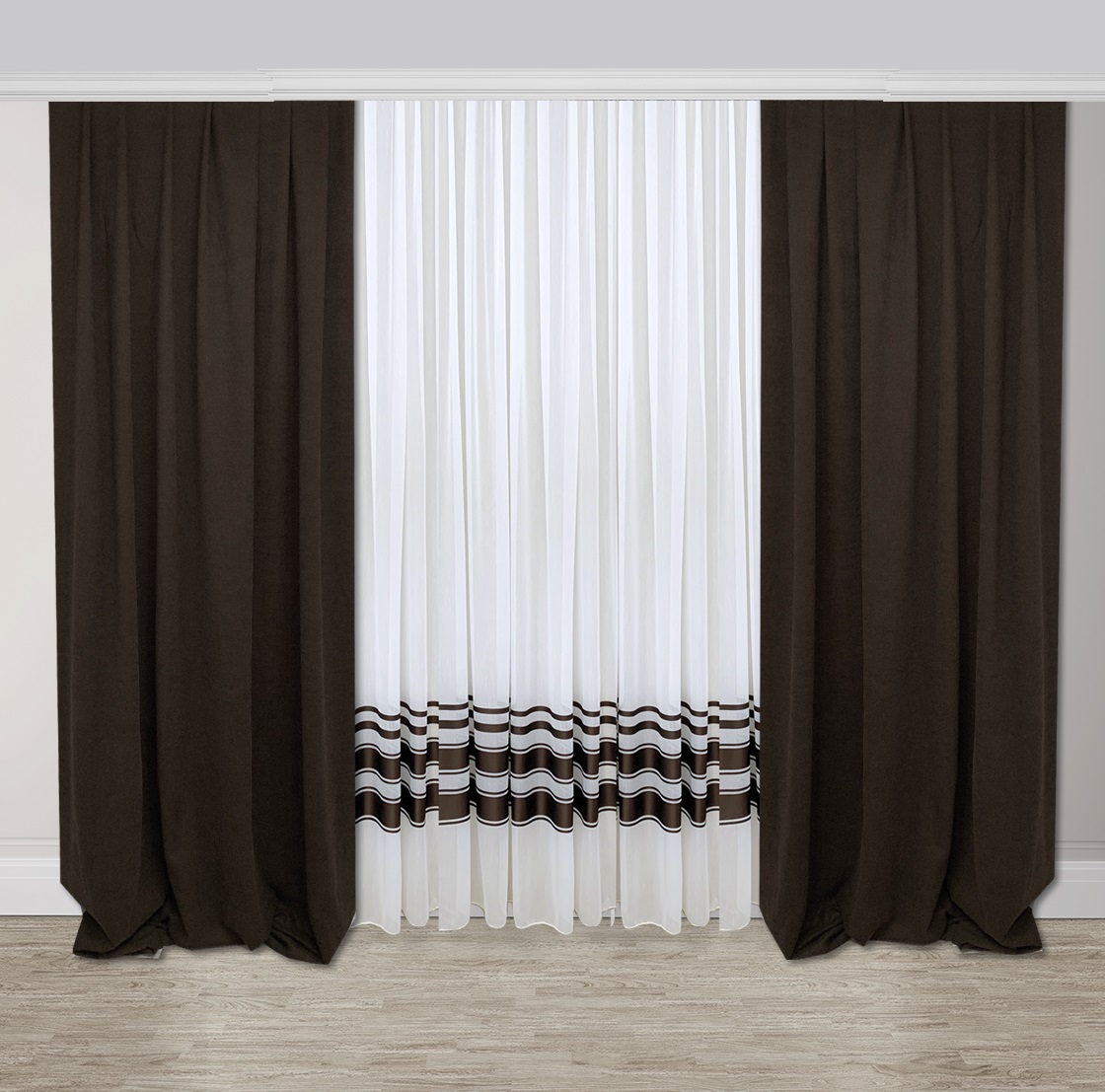
How to hang
The cornice is an integral element in the form of a tubular rod, thin strings, and a flexible profile. The first is considered the most reliable, it can be fixed with ceiling mounts or to the wall. Easily withstands the weight of heavy curtains and curtains. Eyelet rings are put on it.

Less reliable profile. Can be made up of multiple rows for multi-layer tulle constructions. Hooks or clips are strung on it. The string can hold up to three canvases and is invisible under the ceiling.
Long tulle
It's easier to hang a long piece of cloth on a braid that will help create beautiful waves on the fabric, such as:
- forms, when compressed, a relief volumetric row;
- with assembly in the form of a glass;
- thin uniform fold;
- grouped folds in the form of a chicken foot;
- pleats in the form of a bow.

It is better to fix the tulle to the very ceiling, and allow it to touch the floor. This will make the design feel more comfortable. You can combine a long tulle with a short one, directing the folds in different directions or laying in different planes: vertically, diagonally, gathered in a bun with a wide ribbon, or to form stepped folds.
Short tulle
You can also sew a braid on a short tulle or sew a drawstring and thread a cornice bar through it. There is an option to use decorative rings, butterfly-shaped clothespins or in any other form.

At the moment, there is unlimited access to tulle experiments. Combine paints, fabrics and decorations. Create your own designs with great materials.
Video: window decoration with tulle





